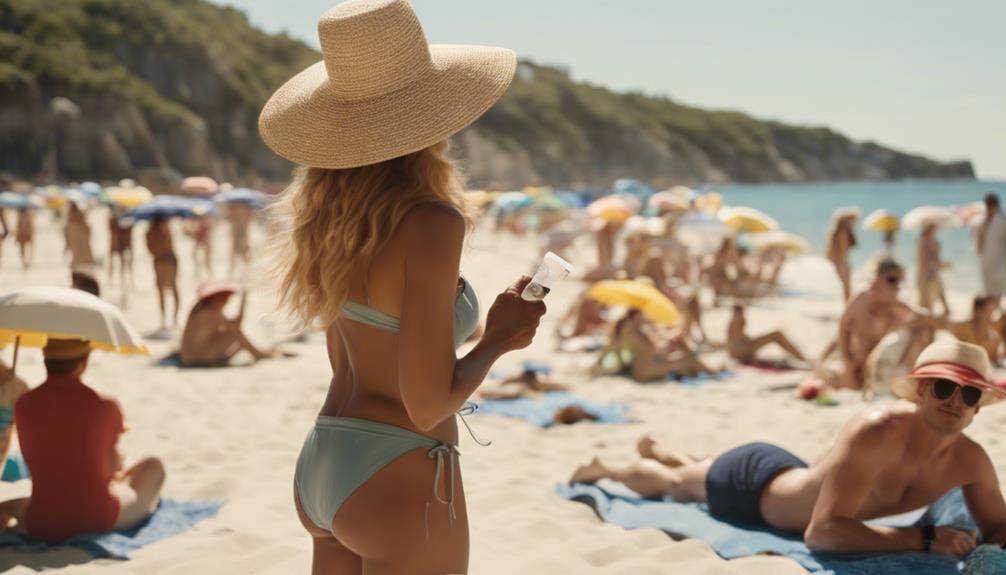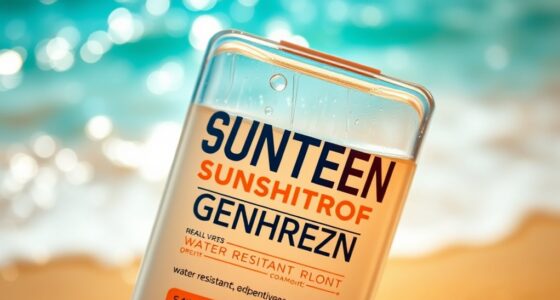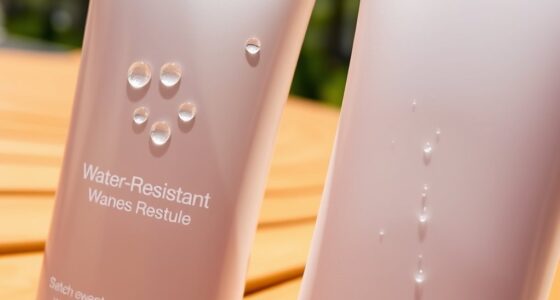Dermatologists want you to know that sunburns are serious and can have lasting effects on your skin. Overexposure to UV radiation causes painful inflammation and increases your risk of skin cancer. You'll notice symptoms like redness, blistering, and peeling as your skin heals. To treat sunburn, take cool baths, apply aloe vera, and stay hydrated. Always use a broad-spectrum sunscreen with at least SPF 30, and reapply often, especially when sweating or swimming. When sunburn is severe or covers a large area, seek medical help. There's much more to learn about keeping your skin safe and healthy in the sun.
Key Takeaways
- Sunburn is a serious injury; even mild cases can lead to long-term skin damage and increased cancer risk.
- Always use broad-spectrum sunscreen with at least SPF 30, applying it 15 minutes before sun exposure.
- Reapply sunscreen every two hours, or more often if swimming or sweating, to maintain protection.
- Protective clothing and seeking shade during peak UV hours can significantly reduce sunburn risk.
Understanding Sunburns
Sunburns often happen when you overexpose your skin to UV radiation, causing painful inflammation and damage. When your skin absorbs too much UV light, it reacts by producing more melanin, leading to redness and discomfort. There are three degrees of sunburn: first-degree burns cause mild redness, second-degree burns can lead to blistering, and third-degree burns require medical attention due to severe damage.
Understanding sunburn's impact is essential for your skin's health. Over one-third of U.S. adults experience sunburn each year, emphasizing the importance of protection against UV radiation. Repeated exposure to the sun without adequate protection can increase your risk of skin cancer and accelerate skin aging. To avoid these long-term effects, it's important to take preventive measures.
Always apply sunscreen with a high SPF before heading outside, even on cloudy days. Remember to reapply every two hours, especially if you're swimming or sweating. Wearing protective clothing, hats, and sunglasses also helps shield your skin from harmful rays.
Recognizing Symptoms of Sunburn

After understanding how sunburns occur, it's important to recognize their symptoms to address them promptly and effectively.
When you expose your skin to the sun's UV radiation, keep an eye out for these key symptoms of sunburn:
- Redness and tenderness: These usually appear a few hours after UV exposure, signaling a first-degree burn.
- Blistering: If you notice blisters forming, that's a sign of a second-degree sunburn, indicating more severe skin damage.
- Peeling skin: This often occurs as your body begins to heal, shedding damaged skin cells.
In severe cases, sunburn can lead to systemic symptoms like fever, chills, and nausea. If these worsen, you may need medical attention.
It's essential to recognize the severity of your sunburn; if extensive blistering covers around 30% of your body, seek immediate help.
By recognizing these symptoms early, you can take steps to protect your skin and guarantee proper recovery.
Always remember that prevention is better than cure—use sunscreen, wear protective clothing, and limit your sun exposure to keep your skin healthy.
Treatment Options for Sunburn

When you experience sunburn, there are several effective treatment options available to alleviate pain and promote healing. Start with cool baths or showers to relieve discomfort. Aloe vera-based moisturizers can help soothe the skin while aiding recovery. Don't forget to hydrate—drinking plenty of water combats dehydration caused by sunburn. Over-the-counter pain relievers like ibuprofen or aspirin can reduce swelling and pain effectively.
For more severe cases, especially with blistering, seek medical attention. Blisters should remain intact to protect the underlying skin from infection. Dermatologists might recommend topical corticosteroids to manage inflammation, but use them under guidance.
Here's a quick comparison of treatment options:
| Treatment Option | Purpose |
|---|---|
| Cool Baths or Showers | Immediate pain relief |
| Aloe Vera Moisturizers | Soothe the skin and promote healing |
| Over-the-Counter Pain Relievers | Reduce swelling and pain |
| Topical Corticosteroids | Treat inflammation in severe cases |
Prevention Strategies for Sunburn

To effectively prevent sunburn, you should apply broad-spectrum sunscreen with an SPF of 30 or higher at least 15 minutes before heading outdoors. This guarantees you get adequate sun protection against harmful UV radiation. Remember to reapply every two hours, or more often if you're swimming or sweating.
Here are three key strategies to enhance your sunburn prevention:
- Wear Protective Clothing: Don long sleeves, wide-brimmed hats, and UV-blocking sunglasses. These items act as barriers against the sun's rays, reducing your risk of sunburn and skin aging.
- Seek Shade: You're most at risk between 10 AM and 4 PM when UV radiation is strongest. Whenever possible, find shade during these peak hours to minimize sun exposure.
- Avoid Tanning Beds: Tanning beds can greatly increase your risk of skin damage and long-term health issues, including skin cancer. Opt for safer alternatives to achieve that sun-kissed look.
When to Seek Medical Help

Knowing when to seek medical help for sunburn can make a significant difference in your recovery and overall health.
If your sunburn covers more than 30% of your body or if you notice extensive blistering, it's time to consult a healthcare provider. These signs indicate a severe burn that requires professional care.
You should also seek immediate medical help if you develop symptoms of heatstroke. A body temperature exceeding 103°F, confusion, or a rapid pulse alongside severe sunburn are critical signs to watch for.
Persistent pain or worsening symptoms, such as increased redness, swelling, or fever, may signal an infection or other complications that need medical attention.
Additionally, if you find it difficult to regulate your body temperature or experience severe dehydration, don't hesitate to reach out to a healthcare professional.
This is especially important for individuals with weakened immune systems or pre-existing skin conditions, as they may need to seek advice sooner if they experience significant sunburn symptoms.
Frequently Asked Questions
What Do Dermatologists Say About Sun Protection?
Dermatologists stress using broad-spectrum sunscreen with at least SPF 30, applying it every two hours, and wearing protective clothing. They also recommend avoiding peak sun hours to effectively shield your skin from harmful UV rays.
What Are Some Fun Facts About Dermatologists?
Did you know dermatologists can perform cosmetic procedures like Botox? They're not just skin doctors; they also research new treatments, making dermatology one of the fastest-growing specialties due to increasing demand for skin care expertise.
Can Sunburns Have Long-Term Effects on the Skin?
Sunburns can indeed have long-term effects on the skin. Excessive sun exposure can lead to skin damage, premature aging, and an increased risk of skin cancer. It’s important to protect your skin from the sun’s harmful rays to minimize the potential long-term effects and erase sunburn memory.
Conclusion
So, next time you feel that sting after a day in the sun, remember that sunburns aren't just a temporary inconvenience—they can lead to long-term skin damage.
Picture your skin, vibrant and healthy, thriving under the sun's rays without fear. By taking simple precautions and knowing how to treat sunburns, you can enjoy the outdoors without the painful aftermath.
Your skin deserves the best care, so don't let a sunburn dim your sunny adventures!









